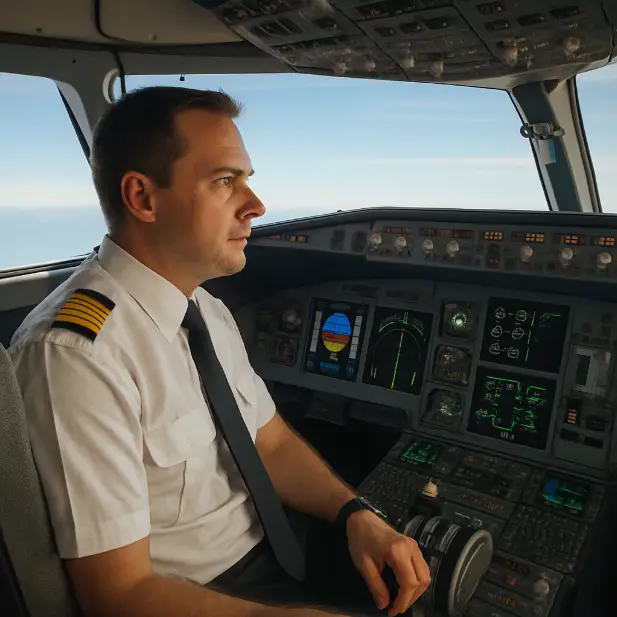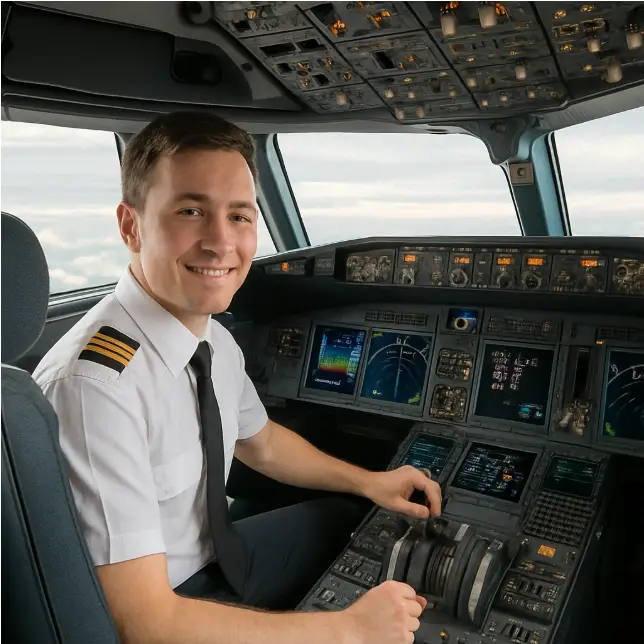From PPL to Pro How to Turn Your License Into a Career

- aviatorpro_6714
In this guide, we will explore the critical steps and career development strategies necessary to turn your PPL into a rewarding career. We will delve into the nuances of transitioning careers within the aviation industry, providing you with actionable insights to propel your journey from an aspiring pilot to a seasoned professional. Understanding the landscape, recognizing the importance of networking, and embracing technological advancements are key elements we’ll cover to ensure you are well-prepared for the challenges ahead.
Understanding the PPL to Pro Career Transition
The transition from holding a PPL to becoming a professional pilot is multifaceted, involving not only acquiring additional certifications and experience but also understanding the aviation industry’s dynamics. It’s essential to recognize that this transition is not merely about accumulating flight hours but also about developing a robust skill set that includes technical proficiency, situational awareness, and effective communication. This comprehensive skill set is what distinguishes a hobbyist from a professional in the aviation sector.
Moreover, the aviation industry is heavily regulated, and staying abreast of regulatory changes is crucial. Understanding the legal and safety requirements that govern aviation operations is an integral part of your professional development. Building a career in aviation also means adapting to technological advancements and industry trends, ensuring that your skills remain relevant and competitive in a rapidly evolving field.
The Foundation: Building on Your PPL
Your PPL is the first stepping stone in your aviation career. It signifies your ability to operate an aircraft and understand the fundamental principles of flight. However, transitioning to a professional role requires further certifications, such as a Commercial Pilot License (CPL) and an Airline Transport Pilot License (ATPL). These certifications signify not just technical competence but also a commitment to maintaining high standards of safety and professionalism.
Additionally, the PPL serves as a foundation upon which you will build specialized knowledge and skills. Understanding complex aircraft systems, mastering emergency procedures, and developing the ability to make quick, informed decisions are critical components of the advanced training you’ll undertake. Each new certification builds upon the last, culminating in a comprehensive understanding of both the technical and operational aspects of aviation.
Earning Additional Certifications
To advance your career, consider enrolling in advanced flight training programs. These programs will not only prepare you for the CPL and ATPL exams but also hone your skills in various aircraft types and flight conditions. Specialized training programs often simulate real-world scenarios, providing hands-on experience that is invaluable in professional settings.
- Commercial Pilot License (CPL): A CPL allows you to be compensated for flying. It requires additional flight hours and a deeper understanding of aviation regulations and procedures. The CPL curriculum often includes advanced aerodynamics, aircraft systems, and meteorology, equipping you with the knowledge needed to operate complex aircraft safely.
- Instrument Rating (IR): An IR is crucial for flying in diverse weather conditions. It enhances your ability to navigate aircraft using instrument-based guidance, a vital skill for any professional pilot. Proficiency in instrument flying is essential for commercial operations, where weather conditions can often be unpredictable and challenging.
- Multi-Engine Rating (MER): This certification is essential if you aim to fly larger, multi-engine aircraft, which is common in commercial operations. Mastery of multi-engine dynamics, such as handling engine failures, is critical for ensuring safety and efficiency in complex flight operations.
Accumulating Flight Hours
Flight hours are a critical aspect of your career progression. They not only demonstrate your experience and reliability as a pilot but are also prerequisites for advanced certifications. Engage in diverse flying opportunities, such as flight instruction, banner towing, or aerial surveying, to accumulate hours and broaden your experience. Each type of flight operation offers unique challenges and learning opportunities, enhancing your versatility as a pilot.
Moreover, aim to diversify your flight experience by operating different aircraft types and flying in various geographic regions. This breadth of experience will make you a more adaptable and marketable pilot, capable of handling a wide range of flying conditions and operational environments. Building a portfolio of diverse flight experiences can also set you apart in the competitive aviation job market.
Career Development Strategies
Developing a career in aviation extends beyond flying skills. It encompasses networking, continuous education, and strategic planning. Here are some career development strategies to consider, each playing a crucial role in your professional growth and success in the aviation industry.
Networking Within the Aviation Community
Building a robust professional network can open doors to opportunities that might not be advertised publicly. Attend aviation seminars, join pilot associations, and participate in online aviation forums to connect with industry professionals. Networking can lead to mentorship opportunities, job leads, and valuable industry insights. Engaging with peers and industry veterans can also provide guidance and support as you navigate your career path.
In addition, consider volunteering for aviation events or joining aviation clubs. These activities not only enhance your visibility within the community but also demonstrate your passion and commitment to the field. Building strong relationships with mentors and colleagues can be instrumental in advancing your career and overcoming challenges.
Continuing Education and Specialization
The aviation industry is dynamic, with technological advancements and regulatory changes continually shaping the landscape. Stay informed by pursuing continuing education opportunities, such as advanced aviation courses and seminars. Specializing in areas like aviation safety, flight instruction, or aviation management can also enhance your career prospects. Each specialization offers unique career pathways and opportunities for advancement.
Furthermore, staying current with industry trends and innovations is vital for long-term success. Consider pursuing additional certifications in emerging fields such as drone operations or sustainable aviation technologies. These specializations not only broaden your skill set but also position you as a forward-thinking professional in the industry.
Gaining Experience in Diverse Roles
Experience in various aviation roles can provide a comprehensive understanding of the industry and enhance your versatility as a pilot. Consider roles such as flight instruction, charter services, or corporate aviation. Each role offers unique challenges and learning experiences that contribute to your professional growth. These diverse experiences can also help you identify your strengths and preferences, guiding your future career decisions.
Moreover, taking on different roles can build resilience and adaptability, qualities highly valued in the aviation sector. Exposure to various operational environments and challenges enhances your problem-solving skills and prepares you for leadership roles. A well-rounded experience portfolio can significantly enhance your career prospects and open up new opportunities.
Transitioning Careers: Challenges and Solutions
The path from PPL to a professional pilot is fraught with challenges, including financial investments, rigorous training, and the competitive nature of the aviation industry. Here are some common challenges and solutions to help you navigate these obstacles effectively.
Financial Considerations
Flight training and certification exams can be costly. Explore scholarship opportunities, financial aid, or part-time work within the aviation sector to offset expenses. Some airlines also offer sponsorship programs for promising candidates. Additionally, consider creating a detailed financial plan to manage expenses and ensure that you can sustain your training over the long term.
Researching and applying for scholarships and grants can significantly reduce the financial burden. Many organizations offer financial support to aspiring pilots, particularly those demonstrating exceptional potential or commitment to the field. Understanding the financial landscape and planning accordingly can make the journey more manageable and less stressful.
Balancing Training with Other Responsibilities
Many aspiring pilots juggle training with work or family commitments. Effective time management and setting clear priorities are crucial to maintaining balance. Consider flexible training programs that can accommodate your schedule. Creating a realistic training plan that aligns with your personal and professional commitments can help you stay focused and motivated.
Additionally, communicate openly with family and employers about your goals and training commitments. Their support can be invaluable in managing your responsibilities and achieving your objectives. Balancing training with other aspects of life is challenging, but with careful planning and support, it is achievable.
Overcoming the Competitive Job Market
The aviation job market is competitive, with many qualified candidates vying for limited positions. Differentiate yourself by gaining varied experience, maintaining a spotless safety record, and cultivating soft skills such as leadership and problem-solving. Developing a personal brand that highlights your unique skills and experiences can also set you apart.
Networking and building relationships within the industry can provide access to hidden job opportunities. Engaging in continuous learning and staying informed about industry trends can further enhance your competitiveness. By positioning yourself as a well-rounded and forward-thinking candidate, you can increase your chances of success in the job market.
The Role of Technology in Career Advancement
Technology plays a pivotal role in modern aviation, from advanced flight simulators to digital navigation tools. Familiarize yourself with the latest technological advancements and consider gaining proficiency in areas like unmanned aerial systems (UAS) or data analytics, which are increasingly relevant in the industry. Understanding and leveraging technology can enhance your efficiency and effectiveness as a pilot.
Continuous learning in technology not only improves your operational capabilities but also positions you as a tech-savvy professional. As the aviation industry increasingly integrates technology into its operations, pilots with strong technical skills will be in high demand. Embracing technology can open up new career opportunities and pathways in the ever-evolving aviation landscape.
Conclusion: Charting Your Path to Success
The journey from PPL to a professional aviation career is both challenging and rewarding. By strategically planning your career development, investing in continuous learning, and embracing the dynamic nature of the aviation industry, you can turn your passion for flying into a fulfilling career. Each step in your journey, from acquiring certifications to building experience, contributes to your growth and success.
Remember, the aviation landscape is constantly evolving, presenting new opportunities for those willing to adapt and grow. With determination, perseverance, and a commitment to excellence, you can navigate the skies as a professional pilot, turning your dreams into reality. Embrace the challenges, learn from each experience, and stay focused on your goals to achieve success in the aviation industry.



